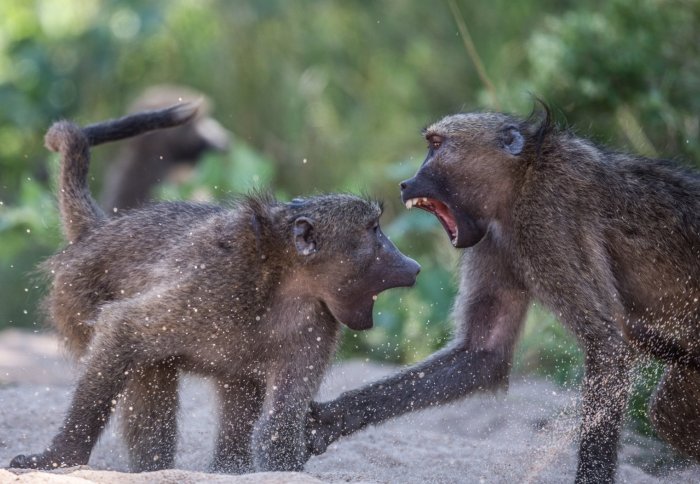
An aggressive interaction between baboons

Using a computer model, Imperial researchers have come up with a better way to determine the dynamics of groups where dominance plays a role.
Dominance hierarchies, where some individuals within a group monopolize resources and mating opportunities, are common throughout the animal kingdom. However, the ‘steepness’ of the hierarchy is different between species.
Our model not only helps researchers design future studies on dominance hierarchies, it can also tell us something about how confident we can be about the results of past studies.
– Alfredo Sánchez-Tójar
For example, baboon groups have a clear ‘alpha’ male, which dominates all others, whereas sparrow groups do not have an individual ruling all others. Researchers determine the structure of hierarchies by observing the interactions of individuals over resources, and who wins in those encounters.
Hierarchies are important because an individual’s position in the group suggests its fitness: its potential for surviving and producing offspring. The principles of animal hierarchies can also be used in social studies of humans.
However, despite hierarchy studies being widespread, there has been little guidance on how much data is needed on each group to be certain of inferring the correct hierarchy structure.
Now, in research published in the Journal of Animal Ecology, Imperial College London, Max Planck Institute and University of Oxford researchers have come up with a new method for giving confidence to hierarchy studies.
Study co-author Alfredo Sánchez-Tójar, from the Department of Life Sciences at Imperial and the Max Planck Institute for Ornithology in Germany, said: “We thought a lot of data would be needed to infer reliable hierarchies, but actually for the steepest hierarchies, like those of baboons, it’s much less than we expected.
“Our model not only helps researchers design future studies on dominance hierarchies, it can also tell us something about how confident we can be about the results of past studies.”
The above video shows sparrows interacting over food, shot by Alfredo Sánchez-Tójar as part of his research.
To create their model, the team simulated artificial individuals, each with a rank or position in the hierarchy. Interactions between the individuals were then simulated, with the results determined by an algorithm that set what percentage of the time a certain rank would win.
With this, the team were able to say how much data needs to be collected to be confident of inferring the correct group structure, depending on the ‘steepness’ of the hierarchy under study.
The team have shared all their data and made their methods open access using the platform ‘Open Science Framework’. They also created an 'R' package that users can freely download and use to conduct their own studies.
-
‘A practical guide for inferring reliable dominance hierarchies and estimating their uncertainty’ by Sánchez-Tójar A, Schroeder J, and Farine DR is published in the Journal of Animal Ecology.
Article text (excluding photos or graphics) available under an Attribution-NonCommercial-ShareAlike Creative Commons license.
Photos and graphics subject to third party copyright used with permission or © Imperial College London.
Reporter
Hayley Dunning
Communications Division

Contact details
Tel: +44 (0)20 7594 2412
Email: h.dunning@imperial.ac.uk
Show all stories by this author





Leave a comment
Your comment may be published, displaying your name as you provide it, unless you request otherwise. Your contact details will never be published.